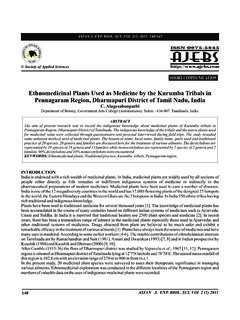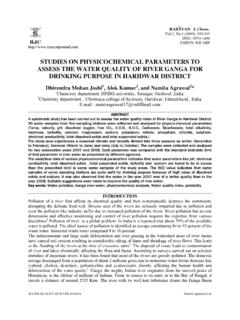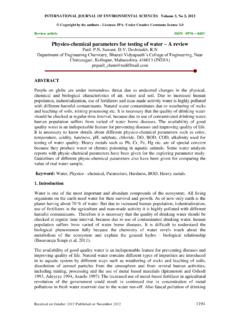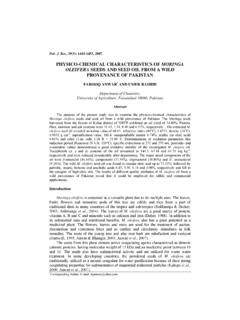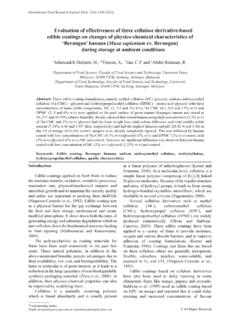Transcription of Physico-Chemical Characterization of Algal oil: a ...
1 ASIAN J. EXP. BIOL. SCI. VOL 2(3) 2011: 493-497. Society of Applied Sciences ORIGINAL ARTICLE. Physico-Chemical Characterization of Algal oil: a Potential Biofuel Pankaj Kumar, Suseela* and Kiran Toppo Algae laboratory, National Botanical Research Institute, Lucknow-226 001, Uttar Pradesh, India ABSTRACT. A total of six naturally occurring Algal biomass bulk samples were collected from different localities of north India. Algae were identified one blue-green alga Tolypothryx and rest five were green algae Pithophora, Spirogyra, Hydrodictyon, Rhizoclonium and Cladophora. Oil was extracted from the dried Algal samples and fatty acid analysis was done.
2 physico - chemical properties of Algal oils such as density, viscosity, lipid content, pH and non-saponifiable fats were estimated. Gas chromatographic analysis revealed higher percentage of methyl palmitate, methyl stearate, methyloleate and methyl linoleate. The Physico-Chemical properties of Algal oil meet all the properties given by American society for testing and materials (ASTM) D6751, ISO 15607and EN14214- Europe. It is concluded that the Algal oil can be used as a potential biofuel. Key words: Algae, biofuel, fatty acid, transesterification, gas chromatography. INTRODUCTION. The need of energy is increasing constantly, because of increase in industrialization and population explosion.
3 The basic sources of energy are fossil fuels (petroleum, coal and natural gas), hydro and nuclear [1] however, fossil sources are limited and will be exhausted by near future [2]. Biodiesel is a biofuel consisting of monoalkyl esters that are derived from organic oils, plant or animal, through the process of transesterification [3]. It is also biodegradable, nontoxic and has low emission profile as compared to petroleum diesel [4].Shay (1993) reported that algae are one of the best sources of biodiesel. In fact algae are the highest yielding feedstock for biodiesel. It can produce 250 times more than the amount of oil per acre as soybeans.
4 In fact biodiesel from algae may be the only way to produce enough automobile fuels to replace current gasoline usage. Algae produce 7 to 31 time greater oil than palm oil [5]. The best algae for biodiesel would be microalgae [6]. Microalgae have much more oil than macroalgae and it is much faster and easier to grow and harvest [7]. The use of microalgae can be a suitable alternative because algae are the most efficient biological producer of oil on the planet and a versatile biomass source and may soon be one of the Earth's most important renewable fuel crops [8]. Higher photosynthetic efficiency, higher biomass production, a faster growth rate than higher plants, highest CO2.
5 Fixation and O2 production, growing in liquid medium which can be handled easily make the algae to stand high in front of other oil seed crops. Their production is not seasonal and can be harvested throughout the year [9, 10]. As a matter of fact, average oil yield from microalgae can be 10 to 20 times higher than the yield obtained from oleaginous seeds and/or vegetable oils (Table 1) [9, 11]. Different types of biofuels can be derived from microalgae. These include methane produced by anaerobic digestion of Algal biomass [12], biodiesel derived from microalgal oil [13-15] and photo-biologically produced bio-hydrogen [16, 17] etc. ASIAN J.
6 EXP. BIOL. SCI .VOL 2(3) 2011 493. Physico-Chemical Charactepaperrization of Algal oil: a Potential Biofuel ..Pankaj Kumar et al. Table-1 Comparison of some sources of biodiesel [9]. Crop Oil yield(L ha-1). Soybean 446. Canola 1,190. Jatropha 1,892. Palm 5,950. Microalgae 136,900. Algae has a great ability to fix CO2, thus it is an interesting method for the removal of gases emitted from power plants and can be used to reduce greenhouse gases with higher production of microalgal biomass and consequently higher biodiesel yield [18,19]. Few microalgae have convenient fatty acid profile and unsaponifiable fraction allowing biodiesel production with high oxidation stability [20-23].
7 The physical and fuel properties of biodiesel from microalgal oil in general ( density, viscosity, acid value, heating value etc.) are comparable to those of fuel diesel [24-26]. Therefore, the present investigation was carried out to test the Algal oil content and their properties to use it as biofuel. MATERIALSAND METHODS. Algal Samples A total of six fresh water algae samples were collected in bulk from different localities of north India. Algal biomass was handpicked from fresh water bodies and immediately after collection; samples were brought to the 0. laboratory, air dried for two days later on dried at 40 C in an oven for 2-3 days till the dry weight was constant.
8 A part of fresh algae samples were observed for identification and preserved in 4% formaldehyde and deposited at Phycology Laboratory of National Botanical Research Institute, Lucknow. The Algal samples collected and analyzed were identified as Tolypothrix- a blue green alga and rest were green algae Pithophora, Spirogyra, Hydrodictyon, Rhizoclonium and Cladophora. Similar dry weights (100g) of all samples were taken for further experiments and analysis. Oil Extraction Dried Algal biomass (5g) was taken in solvent mixture (100 ml) of chloroform and methanol (2:1, ) and the content were refluxed for 4 hrs. After the extraction, the contents were cooled and filtered (or centrifuged) to separate the biomass and washed the biomass with 25 ml of chloroform twice to extract the residual lipids present in the biomass.
9 The extracts were pooled and taken in a separating funnel and washed with 1% aqueous sodium chloride solution (50 ml) twice. The solvent layer was passed through anhydrous sodium sulphate (sodium sulphate was taken in a glass funnel with cotton plug) and removed the solvent using rota-evaporator under vacuum to get the Algal oil. The weight of Algal oil was taken to determine the oil content in biomass. If the biomass is available in smaller quantities, the content may be reduced accordingly. The Physico-Chemical parameters of oil such as pH, viscosity, density were analyzed by standard methods of analysis (AOAC, 1995) and Algal oil characters were compared with biofuel standards contained in ISO15607and EN14214.
10 Isolation of Unsaponifiables 2g Algal oil dissolved in 200 ml of ethanol potassium hydroxide (2M) was refluxed for 1h. The reaction mixture was diluted to 200 ml with distilled water and transferred to a separating funnel. The unsaponifiables were extracted three times with 100 ml of dietheylether. The ether extracts were first washed with 100 ml of aqueous solution of potassium hydroxide ( M) to remove any residual free fatty acids. Further washing and cleaning was carried out five times with 100ml distilled water, and the ether layer removed in a rotary evaporator. The value was expressed in weight percent (w/w). Transesterification ofAlgal Oils The algae oil (400 mg) and 15ml methanolic sulphuric acid [2% sulphuric acid dissolved in methanol (wt/vol)] were 494 ASIAN J.
